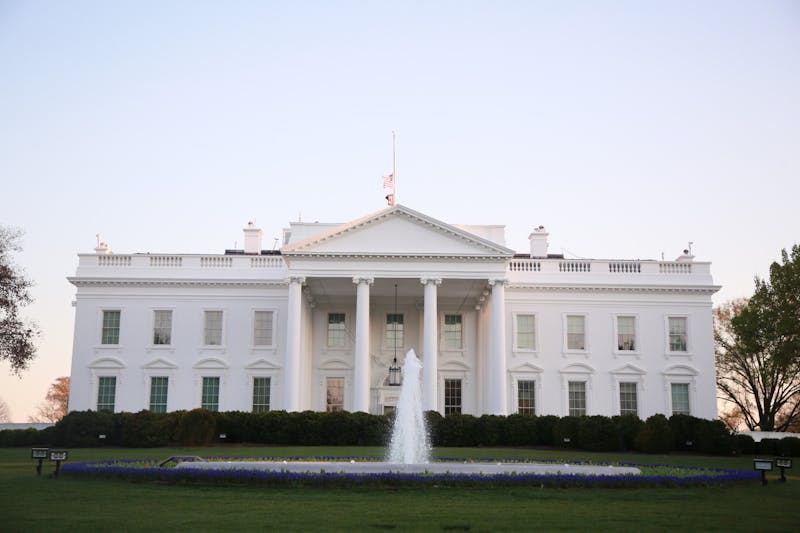
Samantha Sharf
Elements of Style
I have spent many happy hours flipping through the pages of Vogue and could fill a semester of columns with lessons learned in my mother’s closet.
So I couldn’t help but feel a bit of jealousy that last week, while I was shopping classes and negotiating the renovated runway of Locust Walk, New York was celebrating Fashion Week. For eight days, the stylish elite watched the world’s top designers unveil their spring/summer 2012 collection. College senior Jocelyn Teece — editor-in-chief of The Walk, Penn’s student run fashion magazine — explained that, for females, the focus was “acid tones and prints.” Men’s lines, she noted, used more neutral colors.
Scanning the lavish media coverage of the event, it struck me how female-dominated fashion seems to be. Of course, this is not news — the industry’s leading internal report is called Women’s Wear Daily. But I began to wonder if this disparity exists as strongly behind the scenes as it does in front of the camera. And, if so, what are the implications of this divide?
Teece interned at Ralph Lauren this summer. She explained that a lot of creative directors are male, but females otherwise control both design houses and fashion magazines. Only a handful of men attend Walk general body meetings.
After pondering if this disparity is a problem, Teece wrote in an email, “Though there is a case to be made for biological or ‘natural’ differences between genders, I think most would agree that we are simply fostered to associate certain qualities with masculinity and others with femininity. Fashion has a sort of feminine stigma, perhaps because of its relation to aesthetics and beauty.”
Joshua Herren, a College junior interested in gender studies and active in the group Feminism/s, pointed out that many top designers are male. Herren is right; roughly 80 designers showed during Fashion Week and at least 25 of them are male, not including designers who may not lend names to their labels.
If men are not totally absent from fashion, why do they seem to be missing from the discourse the industry fosters? The New York Times, for example, ran over 50 articles covering New York Fashion Week, only four of which were explicitly about menswear or men’s role in fashion.
In 2005, after 113 years of publication, Vogue tried to bridge the gap by creating Men’s Vogue. The magazine folded in 2008.
Men — unless permanently installed in a Greco-Roman museum gallery, a Robert Mapplethorpe photo or a Mask & Wig Spring Fling performance — wear clothes too.
Two exhibitions at the Philadelphia Museum of Art (closing this week) attempt to highlight this obvious fact. Together they feature over 100 ensembles and accessories. Text at the entrance to one of the exhibitions explains that, before the late 18th century, “dress functioned as the primary visual emblem of social standing of both sexes in the United States and Europe.” This means that before Ferraris and iPads, men bought clothes.
The text also notes, “It is more common for men to band together to wear distinctive articles of clothing that identify them as a group.” Who hasn’t guessed what frat a guy is in based on his shoes?
Assistant History professor Tamara Walker, who wrote her doctoral dissertation on dress in 19th-century Peru, explained that clothing — and discussion surrounding it — helps strengthen our understanding of a time and place.
In Peru, men had access to finery, but they had less opportunity to play with styles like veils and full skirts. Back then, both genders gave more attention to female dress. There was an “aesthetic appreciation of the female form,” and it was less common to see women outside the domestic domain.
Women are now out in the world, but the focus never shifted. Today, Walker pointed out, men are not subjected to the physical and monetary pressures the fashion industry exerts on women. But that also means they don’t have access to all the stories fashion can tell.
Though fashion has long given preference to females, the general lack of male interest is not innate to men’s nature. By allowing talk about men’s fashion to be a taboo, we are shutting down opportunities for the man on the street to express himself through a medium that provides many women joy and self-discovery.
At the end of the day, fashion and journalism are businesses that respond to principles of supply and demand. As long as women’s clothing sells better, designers will focus on women. Down-the-middle equality is not required, but exerting our demand by reading and commenting on what coverage exists can only help the quest for male enlightenment. And men: new clothes are fun.
Samantha Sharf, a former Managing Editor for The Daily Pennsylvanian, is a College senior from Old Brookville, N.Y. Her email address is samsharf@sas.upenn.edu. Elements of Style appears every Wednesday.
The Daily Pennsylvanian is an independent, student-run newspaper. Please consider making a donation to support the coverage that shapes the University. Your generosity ensures a future of strong journalism at Penn.
DonatePlease note All comments are eligible for publication in The Daily Pennsylvanian.







